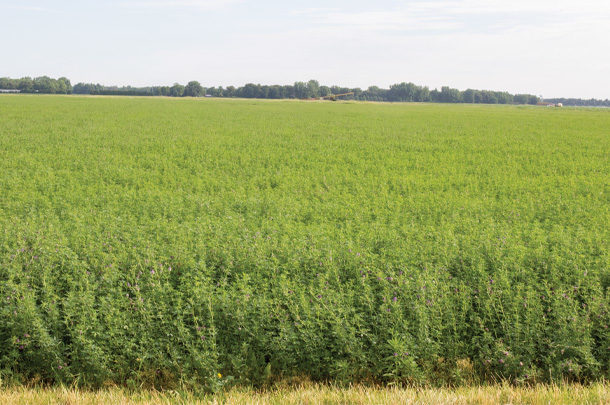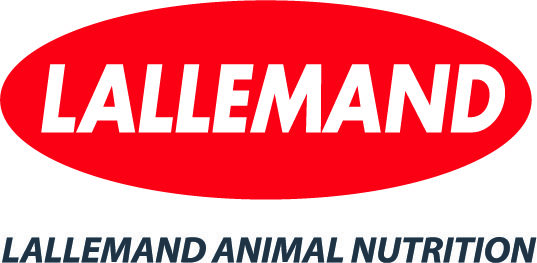To read this article in French, click here.
In recent years, there has been a resurgence in sustainable farming practices and related research, driven mostly by increased interest in improving soil health, nutrient recycling and carbon sequestration. A vast majority of that research has focused on utilization of cover crops, or annual crops cultivated primarily for their soil health benefits. These crops are often terminated at the end of the season, with more economically important row crops following.
However, the benefits of alfalfa have been largely overlooked, even though we have known for many years its vast soil health and ecosystem benefits. From improving soil structure, decreasing erosion, increasing carbon sequestration in soil to decreasing nitrogen fertilizer requirements of subsequent crops, alfalfa is a valuable crop that should be incorporated into cropping rotations for a multitude of reasons. Increased utilization of alfalfa will not only help to reach our goals of improving soil health and increasing carbon sequestration, but it will also help in improving wildlife habitat and biodiversity, critical in improving overall agricultural sustainability, while providing a highly nutritious feedstuff for livestock.
Alfalfa’s impact on sustainability
Sustainability in agriculture has become an important talking point across the government, production and industry landscape. With documented changes in climate affecting everything from temperatures to rainfall, it is important we highlight agriculture’s role in mitigating climate change. While utilizing sustainable farming practices has always served the best business interests of farmers and ranchers, we now recognize that promoting such practices also helps to achieve our climate goals.
In recent years, researchers, growers, industry professionals and government organizations have increased their efforts to define sustainable agriculture and research best management practices that can help to reach those goals. From improving the many facets of soil health to ecosystem benefits, a shift in focus has been placed on methods that can help improve carbon sequestration while also improving overall habitat and ecosystem function. Much of the research to date has focused on the many different species that fall under the classification of “cover crops,” typically annual crops grown specifically for their role in improving soil health. However, alfalfa is an impressive crop whose contributions toward meeting those sustainability goals have largely gone unnoticed. This may have resulted, largely, from the erroneous exclusion of perennial crops, such as alfalfa, from the traditional classification of a “cover crop.”
As shown in Table 1, while many are aware of the vast benefits that support using cover crops, alfalfa has many of the same benefits to offer, if not more.

From its documented ability to sequester carbon in the soil to its ability to decrease nutrient leaching into adjacent soils and watersheds, alfalfa deserves more attention for its contributions toward improving on-farm practices when included in a cropping rotation.
Carbon sequestration
Perhaps one of the most touted aspects of agricultural sustainability is the ability of plants to increase carbon sequestration through photosynthesis. Again, much of the focus has been placed on other resources such as hardwood forests, perennial grasslands and even annual crops, with limited focus on alfalfa’s ability to sequester carbon.
Historical data suggests that alfalfa can sequester significant amounts of carbon in the soil – and, even better, sequester carbon deeper in the soil because of its deeper root structure than many of the other crops commonly evaluated. In 2005, researchers found that when compared to continuous corn cropping, alfalfa sequestered 22% more soil organic carbon (SOC), in agreement with 2016 research which found that alfalfa sequestered 26% more SOC than rotations that included only annual crops (corn and soybean).
Research in 2018 found that when comparing perennial alfalfa to perennial grassland, the amount of SOC was greater in the alfalfa, even when the aboveground biomass was harvested as hay. The amount of carbon sequestered increased in this study if the alfalfa was irrigated, correlating to the amount of both aboveground and below-ground biomass that was produced. The ability of alfalfa to sequester more carbon than other perennial crops is important to note and should also be a talking point when considering programs to implement increased carbon sequestration.
Just as important as total amount sequestered, several of these studies evaluated where the SOC was placed in the soil layers. With many of the other closely studied crops, most of the sequestered carbon is stored in the top 10 centimeters of soil, close to the soil surface. However, it appears that alfalfa has the ability to place carbon deeper in the soil, with gains found at 30 to 60 centimeters. Interestingly, in that same study, the corn-soybean rotation found losses in SOC in those deeper layers.
As carbon markets begin to become more established, it is critical we bring focus to the importance of utilizing alfalfa in cropping rotations. More emphasis needs to be placed on utilization of alfalfa by these carbon market platforms if the objective is to maximize carbon sequestration potential. Thanks to its improved ability to sequester carbon compared to many other crop options, producers are more likely see a financial benefit if they choose to enter the carbon markets by incorporating alfalfa on-farm.
Conclusion
When looking to maximize agriculture’s impact on improving carbon sequestration, it is critical to highlight alfalfa’s important role. Not only can alfalfa significantly increase carbon sequestration, but it also has the potential for so many other beneficial impacts for our ecosystems. The ability to decrease the reliance on nitrogen fertilizers can significantly help at the farmgate by reducing input costs, as well as decreasing emissions. It also is an important crop to help improve soil’s resilience in a changing climate, which can help to maximize production on a per-acre basis.
Finally, it has many benefits to offer wildlife, pollinators and soil-dwelling organisms, which all play a critical role in a healthy ecosystem. It is important that more focus is placed on utilizing alfalfa’s many benefits at the producer level and potentially in funded sustainability programs.










